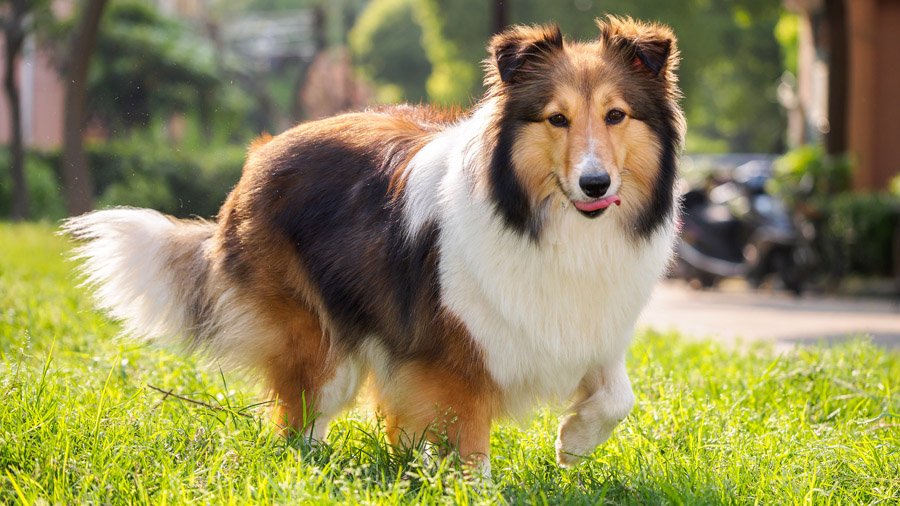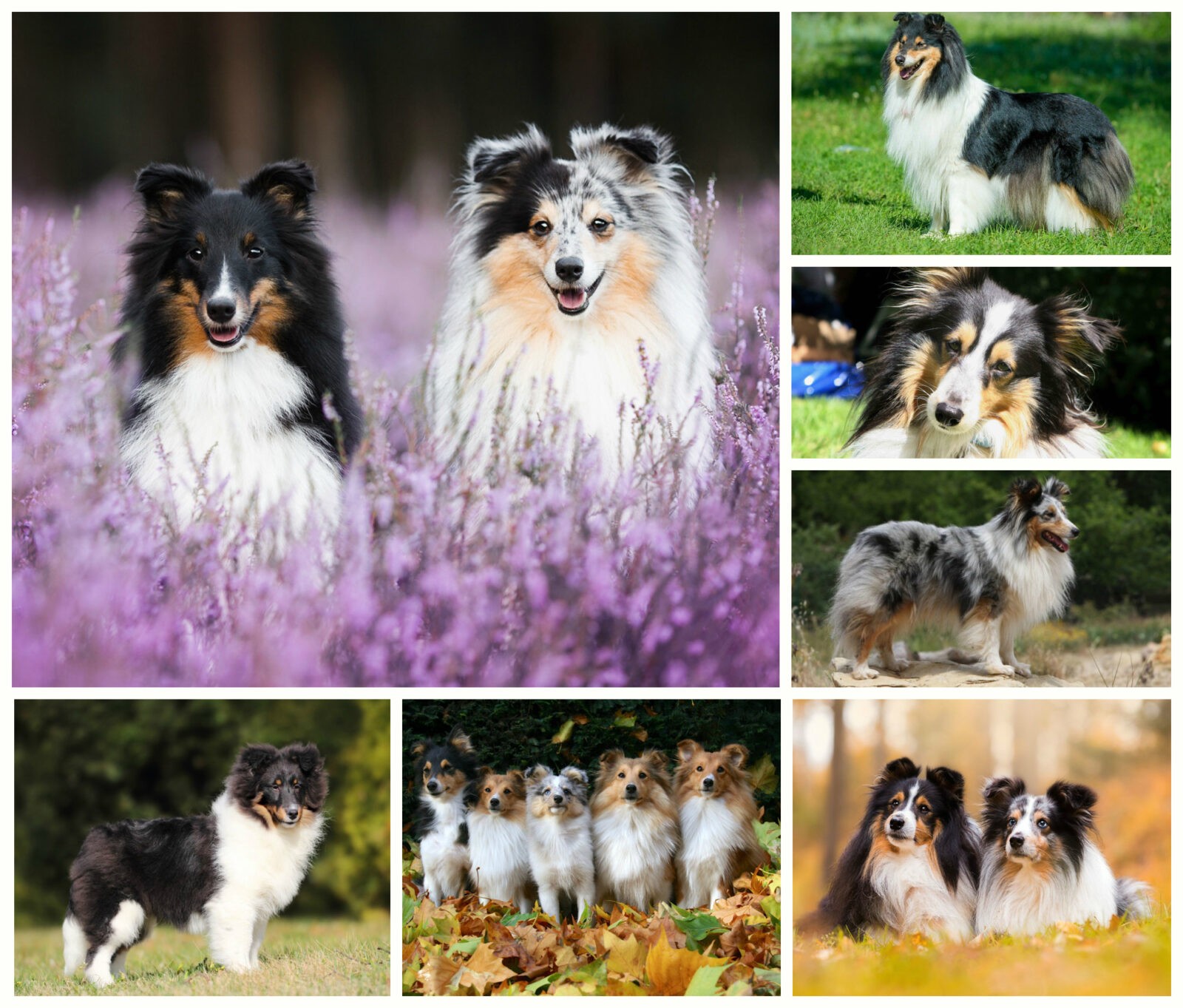
Краткое описание породы шелти
Шелти выглядит как миниатюрная колли. У нее красивая густая шерсть и очень гибкое тело. Голова шелти несколько удлиненная и зауженная. У нее темные миндалевидные глаза и черный нос. Синие глаза у этой породы встречаются крайне редко. Небольшие уши шелти всегда стоячие. Тело собак этой породы мускулистое, но не тяжелое. Отличительной чертой шелти является наличие некой львиной гривы темного цвета. Основной окрас — черный с наличием пятен белого и подпалого цвета.
Шелти, которые долгое время были верными друзьями шотландских фермеров, склонны бить тревогу при возникновении опасности, хотя часто они могут лаять даже на птиц, залетевших в хозяйский сад. Все это — результат пастушьего прошлого животного, который верно служил на пастбищах.
Несмотря на то, что шетлендская овчарка выглядит как уменьшенная колли, все же это две совершенно разные породы. Из этих собак получаются отличные сторожа. Но всего этого можно добиться лишь путем правильного воспитания и обучения.
Шелти — это настоящий компаньон для всех членов семьи, в том числе и для детей. При этом они могут проявлять стеснение при незнакомцах. Особенный характер этой собаки сформирован таким образом, что шелти поднимет лай при малейшем подозрении в возникновении опасности. Если вам захочется избавиться от такой черты характера, то придется приложить усилия в воспитании питомца.
Любой владелец шелти с уверенностью скажет, что собаки этой породы очень умны. По словам доктора Стенли, эксперта по интеллектуальному развитию животных, шелти — одна из самых умных собак. По результатам его исследований, которые он проводил на собаках 132 разных пород, шелти заняла шестое место. Она способна понять новую команду, которую слышит впервые.
Из-за хорошего интеллекта, безумного желания угодить своему хозяину и отличным атлетическим способностям эти собаки занимают лидирующие позиции по популярности среди собак соответствующих размеров. Особых успехов шелти добиваются в соревнованиях, связанных с выполнением разных команд. Также они проявляют непревзойденные способности в заданиях, связанных с ловкостью и поиском.
Исходя из того, что шелти имеет репутацию очень умной собаки, она нуждается в большом количестве упражнений интеллектуальной направленности. В случае отсутствия умственной стимуляции питомцу станет скучно. А это значит, что собака начнет самостоятельно искать для себя развлечения, которые могут не понравиться хозяину.
У шелти сохранился ярко выраженный пастуший инстинкт. Любой заметит, что собака не упустит возможности погоняться за мелкими животными, а когда догонит их, то будет их покусывать, то есть делать то, что обычно они делают во время выпаса овец. Эту привычку необходимо контролировать. Дело в том, что подобное поведение может проявляться по отношению к детям, а это может привести к нежелательным последствиям. Вот почему необходимо пресекать попытки собаки устраивать погоню за животными.
Находясь в помещении, шелти не проявляют особой активности. Поэтому содержать собаку этой породы можно и в квартире. Правда, в этом случае питомца необходимо загружать активными упражнениями. При проживании в частном секторе лучше всего оградить двор надежным забором, чтобы ваш любимец не устремился в погоню за мелкими животными или автомобилем.
Шелти — это собака с длинной густой шерстью, подверженной активной линьке. Многие, приобретая собаку этой породы, даже не представляют, сколько шерсти появится у них в доме при недостаточном уходе за собакой.
Шелти может быть неплохим выбором для работающих людей. Собаки этой породы вполне спокойно могут переносить время одиночества пока хозяин на работе, но для этого необходимо уделять собаке много внимания в свободное время. Животное не должно ощущать себя брошенным и ненужным. Лучше всего шелти развиваются в семьях, где им уделяют очень много внимания, где с ними играют, ласкают и т.д. Такое отношение к домашнему любимцу вернется семье с торицей.
Основная информация
| Название породы: | Шелти |
| Страна происхождения: | Великобритания |
| Время зарождения породы: | XIX век |
| Тип: | пастушьи и скотогонные |
| Вес: | 12 – 15 кг |
| Рост (высота в холке): | 33 – 41 см |
| Продолжительность жизни: | 12 – 14 лет |
|
Классификация МКФ:
|
Группа 1, Секция 1, Номер 88 |
| Цена щенков: | 220 – 450 $ |
| Самые популярные клички: | список кличек для шелти |
Оценка характеристик породы
| Адаптивность
(определение, означающее, насколько легко собака может приспосабливаться к изменениям в жизни) |
🐶🐶🐶🐶🐶 |
| Уровень линьки
(Уровень и частота выпадения волос у животного) |
🐶🐶🐶 |
| Уровень нежности
(Уровень и количество нежности и ласки, которую собака отдает взамен на внимание к себе) |
🐶🐶🐶🐶🐶 |
| Потребности в упражнениях
(Уровень дневной активности собаки) |
🐶🐶🐶 |
| Социальная потребность
(Необходимое количество контактов собаки с другими животными, а также людьми) |
🐶🐶🐶🐶 |
| Квартирное содержание
(Фактор, определяющий уровень шума и иных неудобств, которые собака может доставлять хозяевам в соотношении размера квартиры к размеру собаки) |
🐶🐶 |
| Груминг
(Количество купаний, расчесываний, а также необходимое количество сеансов профессионального груминга, необходимого собаке) |
🐶🐶🐶 |
| Дружелюбность в незнакомой среде
(Особенности поведения собаки в обществе с незнакомыми людьми или в незнакомой обстановке) |
🐶🐶 |
| Тенденция к лаю
(Склонность к лаю и его частоте и громкости) |
🐶🐶🐶🐶🐶 |
| Вопросы здоровья
(Потенциальный уровень состояния здоровья собаки) |
🐶🐶🐶 |
| Территориальность
(Склонность собаки к защите своего дома, двора или даже автомобиля хозяина) |
🐶🐶🐶🐶🐶 |
| Дружелюбность к котам
(Тенденция к терпимости к кошкам и пониженное проявление охотничьих инстинктов) |
🐶🐶🐶🐶🐶 |
| Интеллект
(Способность собаки к мышлению и решению возникающих трудностей (не стоит путать с обучаемостью!) |
🐶🐶🐶🐶🐶 |
| Воспитание и дрессировка
(Уровень сложности в обучении собаки выполнять определенные действия) |
🐶🐶🐶🐶🐶 |
| Дружелюбность к детям
(Фактор, определяющий насколько собака дружелюбна к детям, любит ли она с ними играть и терпеть некоторые детские шалости) |
🐶🐶🐶🐶 |
| Игровая активность
(Понятие определяется самим его названием, и, как правило, встречается почти у всех собак) |
🐶🐶🐶 |
| Наблюдательность
(Способность собаки определить присутствие чужого на своей территории) |
🐶🐶🐶🐶🐶 |
| Дружелюбность к другим собакам
(Склонность собаки находить общий язык с другими своими сородичами) |
🐶🐶🐶🐶 |
Фото шелти:

История происхождения шелти
Порода собак, похожая на колли в миниатюре была выведена на Шетландских островах, которые лежат примерно в 50 километрах от Шотландских берегов. На этих островах появлялось много животных карликовых пород, в том числе шетландские пони, шетландские овцы. Эта местность представляет собой скалистый регион со скудной растительностью. С учетом того, что собака на протяжении истории развивалась на ограниченной территории, вполне объяснимыми становятся размеры собаки.
В восемнадцатом веке Шетландские острова часто посещали рыболовецкие суда. На них на остров попадали многие породы собак, в том числе спаниели, шпицы, различные овчарки. Скрещивание разных пород собак привело к появлению новой породы, которую сейчас мы знаем как шелти.
Интерес к этому животному как к собаке-компаньону начал проявляться лишь в девятнадцатом веке, когда острова посетили английские моряки. Они начали покупать собак этой породы, чтобы содержать их у себя дома.
Первая шелти официально была показана в 1906 году, тогда ее позиционировали как миниатюрную колли. В 1908 году на Шетландских островах был организован клуб шелти. Открыт он был в столице островов — городе Леруик. Порода была признана клубом собаководов Великобритании в 1909 году как шетландская колли. Но уже в 1914 году удалось добиться признания отдельной породы — шелти. Во многом это стало заслугой владельцев колли, которые не очень хотели, чтобы колли сравнивали с шелти.
Американский клуб собаководства зарегистрировал шелти как отдельную породу в 1911 году. В 1929 году был создан клуб поклонников шелти. В этом же году в Лондоне состоялась выставка, на которой была представлена шелти как отдельная порода. После шелти увидели жители Нью Йорка на Дог-клаб шоу. Произошло это в 1933 году. После последовала череда долгих дискуссий по поводу создания стандарта породы и наработки правильных описаний всех нюансов этой породы. Согласно американскому стандарту, рост шелти должен быть в пределах 33-41 сантиметров.
Характер шелти
Содержание и уход
Шерсть шелти требует вычесывания не менее одного раза в неделю. Делать это необходимо специальной массажной щеткой. Такой уход позволит своевременно удалять все отмершие волосы, предотвратит образование катышей и распространение шерсти по дому. Во время вычесывания очень важно начинать расчесывать волосы, начиная от самого их основания. При этом перед расчесыванием на шерсть нужно нанести специальный увлажняющий спрей. Как правило, самцы активно линяют один раз в год, а вот самки – два. Шерсть шелти обладает водонепроницаемыми свойствами. Благодаря чему отталкивается не только влага, но и грязь. Именно поэтому купают собак этой породы лишь по мере необходимости.
Еженедельно необходимо проверять уши шелти на наличие признаков инфекций, воспалений и раздражений. Обрабатывают уши специальным раствором, который должен назначить ветеринар. К еженедельным обязательным процедурам относится и чистка зубов. Это предотвратит возникновение зубного камня и предупредит появление заболеваний десен. Если собака сама не стачивает когти, то их нужно подстригать. Обычно эту процедуру проводят раз в месяц.
Дрессировка и обучение
Здоровье и болезни шелти
Несколько интересных фактов
- Большинство шелти — это активные собаки. Они обладают пронзительным голосом. Чтобы сохранить дружественные отношения с соседями необходимо тренировать собаку с раннего возраста. Питомец должен понимать, когда нужно лаять, а когда — нет.
- Будьте готовыми к активной линьке шелти два раза в год: весной и в любое другое время года (все будет зависеть от особенностей конкретной собаки).
- Шелти чрезвычайно умны. Им требуется достаточно большое количество упражнений. Однако иногда они могут проявлять упрямство. Это случается в тех случаях, когда питомцу скучно. Все упражнения должны быть интересными не хозяину, а собаке.
- Шелти полны энергии. Они обожают активные упражнения, которые сочетаются с интеллектуальными.
- Из-за того, что собаки этой породы пользовались большой популярностью на протяжении многих лет, сложилась нехорошая ситуация с разведением шелти. Не стоит приобретать щенка у случайных заводчиков, они могут страдать от различных генетических заболеваний. Лучше всего совершать покупку у проверенного собаковода. В таком случае вы будет уверенны в том, что щенок здоров и будет нормально развиваться.
Питомники и заводчики
Материал мы заимствовали с замечательного сайта наших партнеров DOGCATFAN.COM о кошках и собаках, автор dogcatfan
